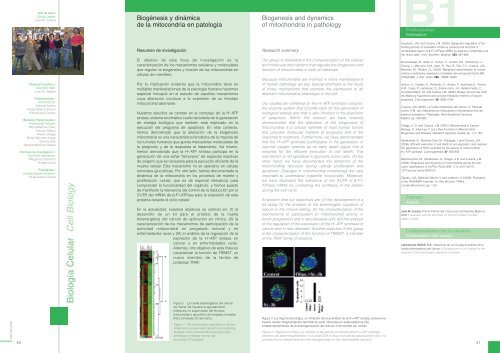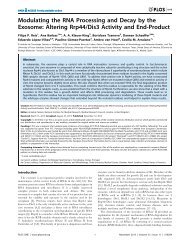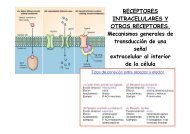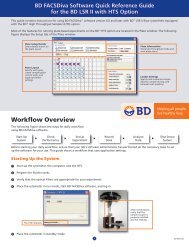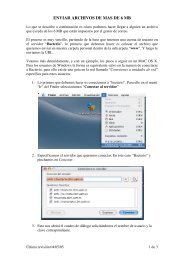Drosophila - Severo Ochoa - Universidad Autónoma de Madrid
Drosophila - Severo Ochoa - Universidad Autónoma de Madrid
Drosophila - Severo Ochoa - Universidad Autónoma de Madrid
Create successful ePaper yourself
Turn your PDF publications into a flip-book with our unique Google optimized e-Paper software.
Jefe <strong>de</strong> línea /<br />
Group Lea<strong>de</strong>r:<br />
José M. Cuezva<br />
Biogénesis y dinámica<br />
<strong>de</strong> la mitocondria en patología<br />
Biogenesis and dynamics<br />
of mitochondria in pathology<br />
B1<br />
Publicaciones<br />
Publications<br />
Resumen <strong>de</strong> investigación<br />
Research summary<br />
Izquierdo, J.M. and Cuezva J.M. (2005). Epigenetic regulation of the<br />
binding activity of translation inhibitory proteins that bind the 3'<br />
untranslated region of β-F1-ATPase mRNA by a<strong>de</strong>nine nucleoti<strong>de</strong>s and<br />
the redox state. Arch. Biochem. Biophys. 433, 481-486.<br />
CBM 2005/2006<br />
40<br />
Personal Científico /<br />
Scientific Staff:<br />
Juan M. Zapata<br />
Postdoctorales /<br />
Postdoctoral:<br />
Paloma Acebo<br />
Amaya Blanco-Rivero<br />
Emmanuelle Guillou<br />
Becarios Predoctorales /<br />
Predoctoral Fellows:<br />
Marta Martínez-Diez<br />
Antonio Isidoro<br />
Alvaro Ortega<br />
María Sánchez-Aragó<br />
Sandra Sala<br />
Vanesa Martínez-García<br />
Técnicos <strong>de</strong> Investigación /<br />
Technical Assistance:<br />
Margarita Chamorro<br />
Piedad Calvo<br />
Estudiantes /<br />
Un<strong>de</strong>rgraduate Stu<strong>de</strong>nts:<br />
Paula García Huerta<br />
Biología Celular Cell Biology<br />
El objetivo <strong>de</strong> esta línea <strong>de</strong> investigación es la<br />
caracterización <strong>de</strong> los mecanismos celulares y moleculares<br />
que regulan la biogénesis y función <strong>de</strong> las mitocondrias en<br />
células <strong>de</strong> mamífero.<br />
Por la implicación evi<strong>de</strong>nte que la mitocondria tiene en<br />
múltiples manifestaciones <strong>de</strong> la patología humana hacemos<br />
especial hincapié en el estudio <strong>de</strong> aquellos mecanismos<br />
cuya alteración conduce a la expresión <strong>de</strong> un fenotipo<br />
mitocondrial aberrante.<br />
Nuestros estudios se centran en el complejo <strong>de</strong> la H + -ATP<br />
sintasa, sistema enzimático cuello <strong>de</strong> botella <strong>de</strong> la generación<br />
<strong>de</strong> energía biológica que también está implicado en la<br />
ejecución <strong>de</strong>l programa <strong>de</strong> apoptosis. En este contexto,<br />
hemos <strong>de</strong>mostrado que la alteración <strong>de</strong> la biogénesis<br />
mitocondrial es una característica fenotípica <strong>de</strong> la mayoría <strong>de</strong><br />
los tumores humanos que aporta marcadores moleculares <strong>de</strong><br />
la prognosis y <strong>de</strong> la respuesta al tratamiento. Así mismo,<br />
hemos <strong>de</strong>mostrado que la H + -ATP sintasa participa en la<br />
generación <strong>de</strong> una señal “temprana” <strong>de</strong> especies reactivas<br />
<strong>de</strong> oxígeno que es necesaria para la ejecución eficiente <strong>de</strong> la<br />
muerte celular. Este mecanismo no es operativo en células<br />
tumorales glucolíticas. Por otro lado, hemos documentado la<br />
dinámica <strong>de</strong> la mitocondria en los procesos <strong>de</strong> muerte y<br />
proliferación celular, que es <strong>de</strong> especial relevancia para<br />
compren<strong>de</strong>r la funcionalidad <strong>de</strong>l orgánulo, y hemos puesto<br />
<strong>de</strong> manifiesto la relevancia <strong>de</strong>l control <strong>de</strong> la traducción por el<br />
3’UTR <strong>de</strong>l mRNA <strong>de</strong> β-F1-ATPasa para la expresión <strong>de</strong> esta<br />
proteína durante el ciclo celular.<br />
En la actualidad, nuestros objetivos se centran en: (I) el<br />
<strong>de</strong>sarrollo <strong>de</strong> un kit para el análisis <strong>de</strong> la huella<br />
bioenergética <strong>de</strong>l cáncer <strong>de</strong> aplicación en clínica, (II) la<br />
caracterización <strong>de</strong> los mecanismos <strong>de</strong> participación <strong>de</strong> la<br />
actividad mitocondrial en progresión tumoral y en<br />
enfermeda<strong>de</strong>s raras y (III) el análisis <strong>de</strong> la regulación <strong>de</strong> la<br />
expresión <strong>de</strong> la H + -ATP sintasa en<br />
cáncer y en enfermeda<strong>de</strong>s raras.<br />
A<strong>de</strong>más, otro objetivo <strong>de</strong> esta línea es<br />
caracterizar la función <strong>de</strong> TRIM37, un<br />
nuevo miembro <strong>de</strong> la familia <strong>de</strong><br />
proteínas TRAF.<br />
Figura 1 . La huella bioenergética <strong>de</strong>l cáncer<br />
<strong>de</strong> mama: Se muestra el agrupamiento<br />
jerárquico no supervisado <strong>de</strong>l fenotipo<br />
mitocondrial y glucolítico <strong>de</strong> biopsias normales<br />
(N) y tumorales (T) <strong>de</strong> mama.<br />
Figure 1 .The bioenergetic signature of cancer:<br />
Graphical unsupervised hierarchical clustering<br />
analysis of the mitochondrial and glycolytic<br />
phenotype of breast normal (N)<br />
and tumor (T) biopsies.<br />
Our group is interested in the characterization of the cellular<br />
and molecular mechanisms that regulate the biogenesis and<br />
function of mitochondria in cells of mammals.<br />
Because mitochondria are involved in many manifestations<br />
of human pathology we pay special emphasis to the study<br />
of those mechanisms that promote the expression of an<br />
aberrant mitochondrial phenotype in the cell.<br />
Our studies are centered on the H + -ATP synthase complex,<br />
the enzyme system that is bottle-neck for the generation of<br />
biological energy and that is also involved in the execution<br />
of apoptosis. Within this context, we have recently<br />
<strong>de</strong>monstrated that the alteration of the biogenesis of<br />
mitochondria is a cellular hallmark of most human tumors<br />
that provi<strong>de</strong>s molecular markers of prognosis and of the<br />
response to treatment. Furthermore, we have <strong>de</strong>monstrated<br />
that the H + -ATP synthase participates in the generation of<br />
reactive oxygen species as an early <strong>de</strong>ath signal that is<br />
required for the efficient execution of cell <strong>de</strong>ath. This<br />
mechanism is not operative in glycolytic tumor cells. On the<br />
other hand, we have documented the dynamics of the<br />
mitochondrial reticulum during cellular proliferation and<br />
apoptosis. Changes in mitochondrial morphology are very<br />
important to un<strong>de</strong>rstand organelle functionality. Moreover,<br />
we have illustrated the relevance of the 3’UTR of β-F1-<br />
ATPase mRNA for controlling the synthesis of the protein<br />
during the cell cycle.<br />
At present time our objectives are: (I) the <strong>de</strong>velopment of a<br />
kit assay for the analysis of the bioenergetic signature of<br />
cancer in the clinical setting, (II) the characterization of the<br />
mechanisms of participation of mitochondrial activity in<br />
tumor progression and in rare diseases and, (III) the analysis<br />
of the regulation of the expression of the H + -ATP synthase in<br />
cancer and in rare diseases. Another objective of the group<br />
is the characterization of the function of TRIM37, a member<br />
of the TRAF family of proteins.<br />
Figura 2 .La oligomicina (oligo), un inhibidor <strong>de</strong> la actividad <strong>de</strong> la H+-ATP sintasa, previene la<br />
muerte celular (fragmentación <strong>de</strong>l DNA en azul) inducida por estaurosporina (St),<br />
in<strong>de</strong>pendientemente <strong>de</strong> la <strong>de</strong>sorganización <strong>de</strong>l retículo mitocondrial (en ver<strong>de</strong>).<br />
Figure 2. Oligomycin (Oligo), an inhibitor of the activity of mitochondrial H+-ATP synthase,<br />
prevents cell <strong>de</strong>ath (fragmentation of nuclear DNA in blue) induced by staurosporine (St), in a<br />
process that is in<strong>de</strong>pen<strong>de</strong>nt from the disorganization of the mitochondrial reticulum.<br />
Govindarajan, B., Shah, A., Cohen, C., Arnold, R.S., Schechner, J.,<br />
Chung, J., Mercurio, A.M., Alani, R., Ryu, B., Fan, C.Y., Cuezva, J.M.,<br />
Martinez, M., Arbiser, J.L. (2005). Malignant transformation of human<br />
cells by constitutive expression of platelet <strong>de</strong>rived growth factor-BB<br />
(PDGF-BB). J. Biol. Chem. 280, 13936-13943.<br />
Isidoro, A., Casado, E., Redondo, A., Acebo, P., Espinosa, E., Alonso,<br />
A.M., Cejas, P., Hardisson, D., Fresno-Vara, J.A., Belda-Iniesta, C.,<br />
Gonzalez-Baron, M. and Cuezva J.M. (2005). Breast carcinomas fulfill<br />
the Warburg hypothesis and provi<strong>de</strong> metabolic markers of cancer<br />
prognosis. Carcinogenesis. 26, 2095-2104.<br />
Cuezva, J.M. (2005). La huella metabólica <strong>de</strong>l cáncer. In: Pascual-<br />
Leone, A.M. (ed.) Mecanismos moleculares y neuroendocrinos <strong>de</strong>l<br />
balance energético: Patologías. Real Aca<strong>de</strong>mia Farmacia.<br />
<strong>Madrid</strong>. pp. 363-383.<br />
Ortega, A. D. and Cuezva, J.M. (2005). Mitochondria in Cancer<br />
Biology .In: Villarroya, F. (ed.) New Frontiers in Mitochondrial<br />
Biogenesis and Disease. Research Signpost, Kerala. pp. 111-139.<br />
Santamaría, G., Martinez-Diez, M., Fabregat, I. and Cuezva, J.M.<br />
(2006). Efficient execution of cell <strong>de</strong>ath in non-glycolytic cells requires<br />
the generation of ROS controlled by the activity of mitochondrial<br />
H+-ATP synthase. Carcinogenesis. 27, 925-935.<br />
Martínez-Diez, M., Santamaría, G., Ortega, A.D. and Cuezva, J.M.<br />
(2006). Biogenesis and dynamics of mitochondria during the cell<br />
cycle: significance of 3’UTRs. PLoS ONE 1 (1): e107.doi:10.<br />
1371/journal. pone.0000107.<br />
Zapata, J.M., Martinez-Garcia, V. and Lefebvre, S. (2006). Phylogeny<br />
of the TRAF/MATH domain. In: Hao Wu (ed). TRAFs.<br />
Lan<strong>de</strong>s Bioscience. pp. 1-23.<br />
Premios<br />
Awards<br />
José M. Cuezva. Primer Premio <strong>de</strong>l I Concurso <strong>de</strong> Patentes Madri+d<br />
2005 / Awar<strong>de</strong>d with the first Prize on The First Patent Contest<br />
Madri+d 2005.<br />
Colaboraciones con la industria<br />
Collaborations with industry<br />
Laboratorios INDAS, S.A.: <strong>de</strong>sarrollo <strong>de</strong> un kit para el análisis <strong>de</strong> la<br />
huella bioenergética <strong>de</strong>l cáncer. / Development of a kit assay for the<br />
analysis of the bioenergetic signature of cancer.<br />
41


